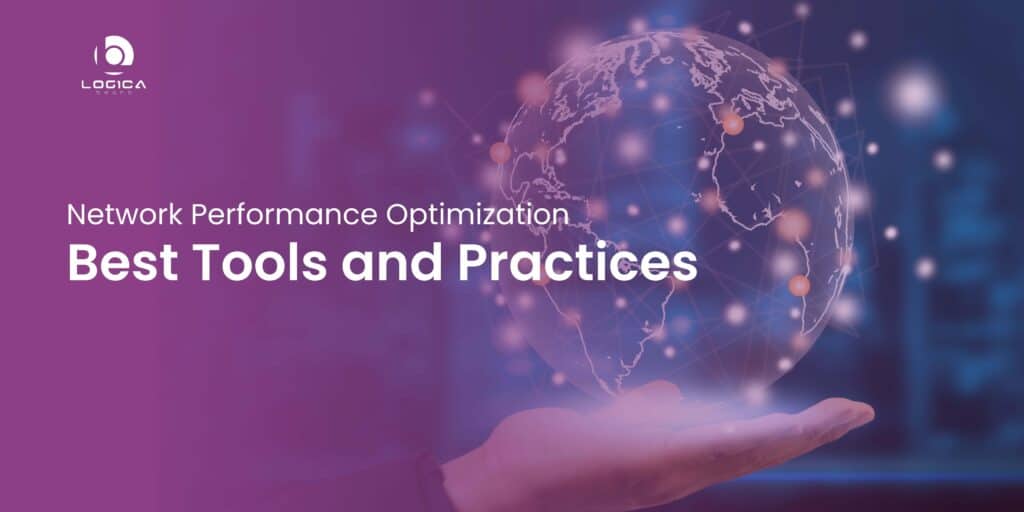Networks are a crucial part of practically any organization’s infrastructure in the current digital era. How well a company can do business, cooperate with partners, and service its consumers is heavily influenced by network performance. Significant productivity, financial, and reputational losses can result from subpar network performance. Therefore, network performance optimization is crucial to guarantee smooth operation and support business objectives.
A network’s speed, dependability, and efficiency are all improved through a process known as network performance optimization. It covers a variety of tasks, including network design and setup, monitoring, and technology installation that improves performance. Organizations must employ technologies that are suitable for their particular needs and best practices to function at their peak.
Network optimization is critical because our linked real-time world is fully reliant on the dependable, safe, and available conveyance of data 24 hours a day, seven days a week. Yet each year, networks are subjected to increasing strain. It is impossible to deny that we live in a data-driven world. Every part of our digital life is dependent on how effectively the network runs, which is why network optimization is essential.
This article aims to provide an overview of network performance optimization, highlighting the best practices and tools that organizations can use to improve their network’s performance. we will discuss some of the challenges and emerging trends in network performance optimization and suggest recommendations for organizations seeking to optimize their network performance.
Importance of network performance optimization
Workplace productivity may be considerably increased by an improved network. Employees can work more productively when they have rapid, easy access to the programs and data they require. Inefficient networks can cause annoyance and time loss, which can be harmful to productivity. Additionally, improved networks can give administrators better visibility and control over network traffic, enabling them to give priority to important applications and guarantee their peak performance.
Network performance optimization is crucial for companies that use networks to provide services to clients. Poor customer experiences brought on by slow or unreliable networks might harm the company’s image. This is particularly true for online retailers, where clients need fast and dependable service. Businesses may make sure their consumers have a good experience by optimizing the network, which can boost customer happiness, loyalty, and repeat business.
Network performance optimization can result in financial savings for companies. Optimized networks can eliminate the need for extra hardware and software, which can be costly to buy and maintain, by utilizing resources more effectively. A speedier network can also shorten job completion times, which can result in cost savings by raising productivity and lowering labor expenses.
A network that has been optimized is safer. Optimized networks may stop downtime and data breaches by swiftly identifying and reacting to possible security threats. For companies that deal with sensitive information, including personal and financial data, this is extremely crucial. Additionally, with better visibility into network traffic that optimized networks can offer, administrators can spot and address potential security threats before they have a chance to do harm.
Having a network that is optimized might provide companies a competitive edge. Businesses can gain an advantage over rivals by responding to market developments and consumer needs more swiftly thanks to a quicker network. Businesses may also improve consumer experiences through network optimization, which can raise client happiness and loyalty.
network performance optimization is critical for businesses and organizations that want to improve productivity, customer experience, cost savings, security, and competitive advantage. By optimizing the network, businesses can increase efficiency, reduce costs, improve security, and gain a competitive edge in their industry.
Network performance optimization metrics:
● Network Availability:
This is one of the most pressing problems for any network manager in charge of mission-critical or business-critical network infrastructures. The proportion of time that a network is operational over a certain time period is referred to as network availability. All network resources, including network devices, interfaces, WANs, SD-WANs, services, processes, apps, and websites, are monitored for availability.
● Network Utilization:
This is a measure of network traffic that indicates whether a network is busy, steady, or idle. It is expressed as a percentage and is computed as a ratio of current traffic to peak load that the network can manage. Spikes in network consumption can have an impact on the performance of the network infrastructure at every tier, and tracking usage surges is necessary. Network administrators can observe how much and where the network is being used at a glance by evaluating incoming and outgoing patterns of bandwidth utilization, allowing them to make educated decisions regarding improvements and maintenance.
● Network Latency:
“Latency” and “delay” are synonyms. Network latency is the measurement of delays in data transfer, whether one-way or round-trip of a data packet. Latency is a network speed indication that is often measured in milliseconds. It has a significant impact on user experience (think VoIP calls or video streaming in particular). Low-latency networks are those that have minor delays. High-latency networks are those with substantial delays.
● Network Jitter:
This happens when a data stream is not consistent, causing certain packets of data to take longer to deliver than others. Jitter is a symptom of a network-congested router, and it generally results in poor online video or audio quality.
● Network Service Delivery and Service Assurance:
The technology that provides the visualization, detection, alerting, and reporting on the state of an end-to-end IT service is known as service delivery monitoring. It is comparable to service assurance, which is a technology and process architecture that ensures that IT services delivered through the company network satisfy the agreed-upon service quality level (SLA) for best user experience. Monitoring and assurance of service delivery occur as a result of optimizing application performance over a heterogeneous network architecture.
Network Performance Optimization Practices:
Network performance optimization is the process of increasing the speed and reliability of a network in order to improve the user experience. The following are some best practices and technologies for network speed optimization which are mostly used during troubleshooting:
● Use Quality of Service (QoS):
Quality of Service (QoS) is a mechanism that prioritizes network traffic depending on its significance. It guarantees that crucial traffic, like video conferencing or VoIP conversations, takes precedence over less important traffic, like email or file transfers. To guarantee that network traffic is delivered fairly and effectively, QoS may be implemented on network equipment such as routers and switches.
● Implement Traffic Shaping:
Traffic shaping is a network traffic management strategy that controls the bandwidth allocated to each application or user. It guarantees that key applications have adequate bandwidth while limiting less important apps. To guarantee that network traffic is controlled efficiently, traffic shaping may be performed on routers and firewalls.
● Optimize DNS Lookup:
Delayed DNS lookups can have a big influence on network performance. You may use a faster DNS server, enable DNS caching, reduce the amount of DNS lookups by consolidating content and utilizing a CDN, allow DNS prefetching, and minimize DNS resolution latency by lowering the distance between your DNS resolver and servers, using a fast DNS resolver, and setting it to utilize many DNS servers in parallel to optimize DNS lookups and enhance network performance.
● Reduce Network Congestion:
When a network is congested, it is transporting more data than it can manage. It causes sluggish network performance and data transmission delays. By improving network design, updating network equipment, and adopting traffic shaping and QoS, network congestion may be decreased.
● Monitor Network Performance:
Monitoring network performance is critical for identifying problems that affect network performance. Tools such as network analyzers, packet sniffers, and bandwidth monitors can be used to monitor network performance. These technologies can aid in the detection of problems such as network congestion, packet loss, and delay.
These are only a few tools and commands for network troubleshooting. There are other different tools and commands available, and their use is dependent on the individual issue being addressed.
Network Performance Monitoring Tools
Network Performance Monitoring (NPM) tools are software applications that help IT administrators monitor and analyze the performance of their network infrastructure. These tools collect data from network devices, such as switches, routers, and servers, and provide insights into the health and performance of the network.
NPM tools typically provide real-time monitoring of network traffic and can identify issues such as packet loss, latency, and bandwidth utilization. They can also track network performance over time, allowing administrators to identify trends and patterns that may indicate larger issues.
Here are some of the network performance monitoring tools
● Wireshark:
Wireshark is a network protocol analyzer, or an application that captures packets from a network connection, such as the one connecting your computer to your home office or the internet. A packet is a distinct unit of data in a standard Ethernet network. Wireshark has several applications, including debugging network performance concerns. Cybersecurity experts frequently use Wireshark to trace connections, inspect the contents of suspicious network transactions, and spot surges of network traffic.
● Zabbix
Zabbix has the function and monitoring capabilities (auto discovery is a notable component), but it adds more sophisticated features, such as a dashboard that can be used to directly configure monitoring choices. Using Zabbix, you can modify and escalate your alerts to give more information and notify a series of on-call people if the initial effort to reach a technician goes unanswered. (In order to stop the escalation process, Zabbix requires you to recognize issues.)
Zabbix is a template-based software that may simply deploy a basic set of monitoring/alerting options across a wide range of systems, such as notifying staff if a host is not pingable, has high resource usage, has disk space concerns, or other common problems.
● SolarWinds Network Performance Monitor
SolarWinds Network Performance Monitor is a network monitoring tool that displays network performance in real time. It monitors network devices, applications, and servers in order to detect problems that affect network performance. NetFlow analysis, packet capture analysis, and SNMP monitoring are all included in SolarWinds Network Performance Monitor.
Future directions in network performance optimization
In order to fulfill the rising need for faster, more dependable networks, new technologies and approaches are continually being developed in the field of network performance improvement. Some of the upcoming developments in network performance improvement are as follows:
● Artificial intelligence and machine learning: By providing real-time monitoring, spotting abnormalities and trends, and foreseeing future problems beforehand, AI and machine learning algorithms can assist enhance network performance. Administrators may use AI to automatically detect problems and change network parameters to improve performance. For instance, routing protocols can be changed to minimize latency and increase throughput when network traffic patterns are analyzed.
● Software-Defined Networking (SDN): SDN, or software-defined networking, is a cutting-edge networking strategy that divides the control and data planes to provide administrators the ability to centrally manage network resources and automate network design and monitoring. By allowing managers to dynamically assign network resources to match the needs of certain applications, SDN can improve network performance. For instance, SDN might give extra bandwidth to a high-bandwidth application operating on the network to ensure maximum performance.
● Cloud-Based Network Management: Without the requirement for on-premises hardware, cloud-based network management technologies provide centralized network control and monitoring from any location. These systems give administrators more flexibility, agility, and scalability, which makes it simpler to adjust to shifting network needs. Additionally, cloud-based network management can automate repetitive management tasks and offer real-time visibility into network performance, freeing up administrators to concentrate on more strategic initiatives.
● Network Automation: The automation of repetitive network administration processes including configuration, provisioning, and troubleshooting via the use of software is known as network automation. Network managers may focus on more complicated duties like improving network performance by automating common processes to decrease the possibility of human mistake and increase productivity. Network performance can be automatically optimized via automation, negating the need for human involvement.
● 5G Networks: The introduction of 5G networks will result in quicker and more dependable connection, opening up fresh possibilities for applications and use cases. However, since 5G networks will be more complicated and require more management and monitoring, this will also necessitate new methods for network performance optimization. To manage 5G networks, network administrators will need to create new management plans that optimize network slicing, QoS (Quality of Service), and security.
Conclusion
Network performance optimization is crucial for businesses to remain competitive in today’s rapidly changing technological landscape. As an organization seeking to optimize network performance, it is essential to assess your network regularly and use monitoring tools to identify potential bottlenecks and performance issues. The improvement of network performance is critical for the seamless operation of any IT system. You can enhance network performance and guarantee dependable and efficient data transfer by applying best practices such as QoS, traffic shaping, and network monitoring. Moreover, tools like Wireshark, NetFlow Analyzer, and SolarWinds Network Performance Monitor can assist in identifying problems.










